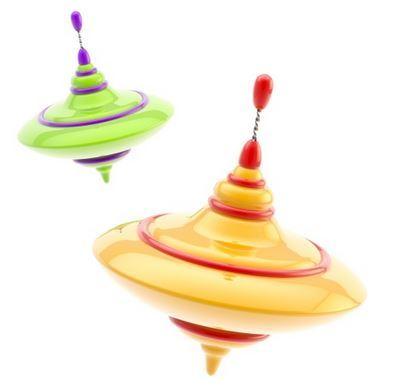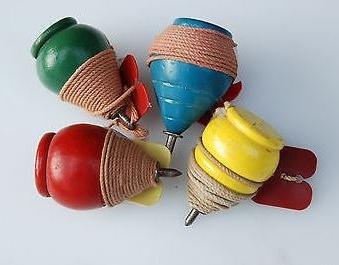The Enduring Little Toy
A spinning top is a conical, spherical or oval object with a pointed tip. When external force is applied to it in a correct manner, the object miraculously stays upright on its tip and spins around its axis.
Of course, there is nothing magical about this phenomenon. It all boils down to physics. Without delving on technical explanations, we’ll trust the physicists when they say that a spinning top would happily stay up rotating forever and ever… were it not for friction and gravity. Those two forces inevitably win in real life. As soon as friction begins to slow the speed of spinning, the top begins to wobble. Then gravity takes over, making the top swing outward and wobble even more as it desperately tries to conserve its momentum. Finally, it falls over and comes to a stop.
For an average child or a grown-up unconcerned with the laws of physics, that merely signifies that the top needs to be picked up and spun again.
And so it was from the dawn of human species. It is believed that spinning top is one of the oldest toys, because many smooth objects found in nature have the ability to rotate around their axis for a relatively long time. It is easy to imagine a group of prehistoric humans watching with amazement as one of their own picks up and acorn, gives it a twirl… and the acorn spins and spins and then spins some more.
We are just as enthralled by that spinning movement today as our ancestors were all those years ago. This fascination is spread across cultures. Spinning tops of different shapes and sizes are found in every corner of the world, with everything pointing to the conclusion that they have been invented independently of each other.
The children of the city of Ur in present-day Iraq played with a clay spinning top about 3500 BC. That is the oldest top found in the archaeological excavations up to now. Tops dating from 2000 to 1000 BC were found in Egypt and in China. Some samples of ancient Greek pottery, made around 500 BC, are decorated with scenes showing top spinners. Spinning toys made of bones were popular in the ancient Rome about 30 years BC.
In more recent times, tops were traditionally manufactured of wood, sometimes with an iron tip. Today they are built out of different materials, such as metal, glass or plastic. With the help of modern materials and technology, tops are constructed with improved balance, making it easier to set them in motion and enabling them to spin for longer.
 Types of Tops
Types of Tops
Spinning tops are classified by the way in which they are spun.
Twirling tops, also called twirlers, are spun by hand. This is the oldest type of spinning top, still popular today.
Supported tops are held upright with a support and spun by a cord. The gyroscope is an example of a supported top.
Whip tops are set in motion and kept spinning with the help of a whip. This was a common toy in the Victorian era Britain.
Throwing tops have a string wrapped around the body and attached to a stick. When the top is thrown, the string is rapidly released, making the top spin.
Pump or humming tops have a crown that is pushed down or pumped several times to create the spin. A pump top is usually made from metal and contains a twisted metal rod and a spring inside which make it spin. They also often have small holes in the sides that produce a humming sound.
How to Make Your Own Spinning Top
Many everyday objects can play the role of a spinning top. With a little effort, you can make your own spinning top and hold a spinning contest with your friends.
You will need a piece of card and a well-sharpened pencil. Cut out a circle from the card, decorate it with bright colours and push a pencil through the middle. Put the top on a smooth surface and give it a twirl.
May the best twirler win!
